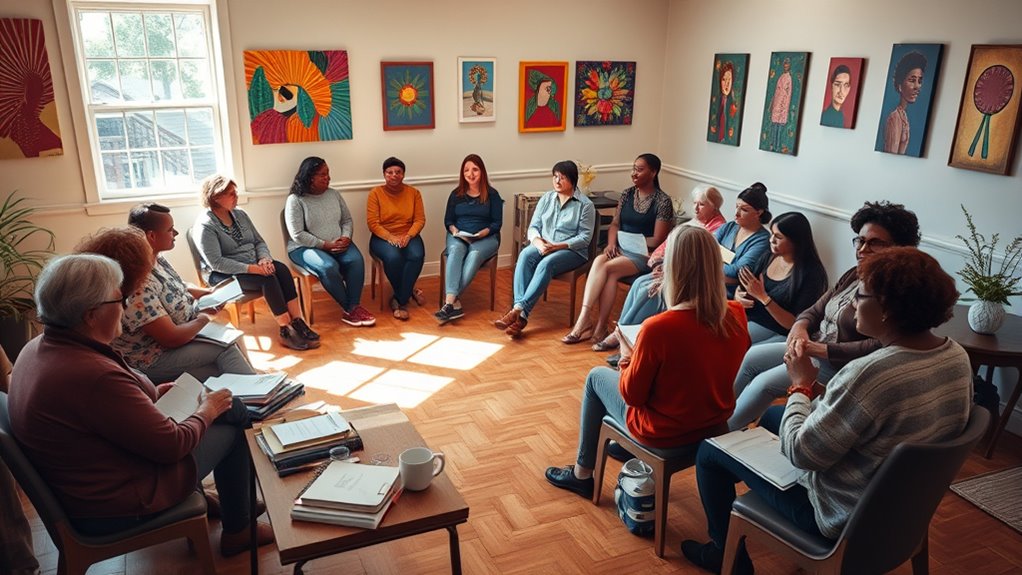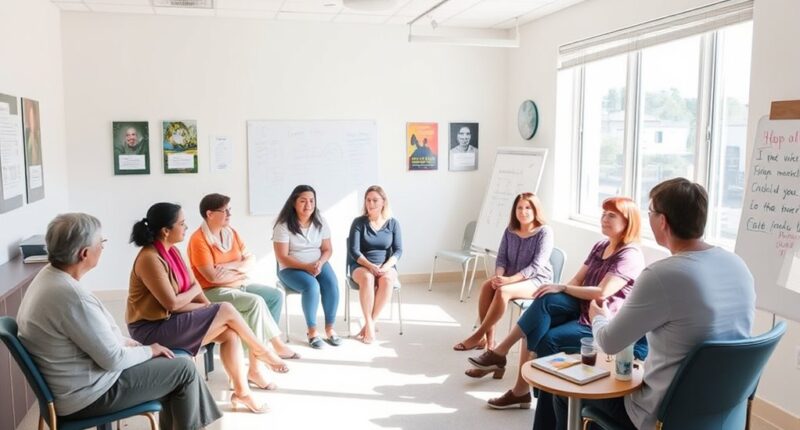Missouri’s successful opioid programs focus on community engagement, expanded access to medication-assisted treatment like buprenorphine and methadone, and the use of telehealth to reach rural areas. They prioritize breaking down stigma and creating accessible pathways to recovery through partnerships with community leaders and health providers. These efforts also include education campaigns, support networks, and collaboration with local agencies. Keep exploring to discover how these strategies come together to save lives and rebuild communities.
Key Takeaways
- Missouri’s programs integrate medication-assisted treatment (MAT) with counseling to improve recovery outcomes.
- Community outreach efforts, including mobile clinics and local education, help reduce stigma and promote treatment access.
- Telehealth services extend treatment to rural and underserved areas, ensuring continuous care.
- Partnerships with community leaders and local organizations foster supportive environments for recovery.
- Evidence-based practices and holistic approaches are prioritized to address both physical and psychological aspects of addiction.

How is Missouri tackling its growing opioid crisis? The state has taken a proactive approach by emphasizing community outreach and innovative treatment methods, especially medication-assisted treatment (MAT). You might notice that local organizations, healthcare providers, and government agencies are working together to reach those most affected. Community outreach plays an essential role because it helps break down the stigma associated with addiction and encourages individuals to seek help without fear of judgment. These outreach programs often involve mobile clinics, educational campaigns, and partnerships with community leaders to guarantee that those struggling with opioid dependence know they’re not alone and that resources are available.
Once someone reaches out for help, medication-assisted treatment becomes a cornerstone of Missouri’s rehabilitation efforts. MAT combines FDA-approved medications such as buprenorphine, methadone, or naltrexone with counseling and behavioral therapies. This approach effectively reduces withdrawal symptoms and cravings, making it easier for individuals to stay in recovery. You’ll find that many treatment centers across Missouri now prioritize medication-assisted programs because they have proven to markedly improve recovery outcomes. By addressing both the physical and psychological components of addiction, MAT offers a more complete solution than traditional methods alone.
Missouri’s strategy encourages community members to become active participants in the recovery process. Outreach isn’t just about informing; it’s about creating accessible pathways for treatment. You might see community health workers conducting home visits or organizing local events that focus on prevention and early intervention. These efforts help connect people to the services they need before their addiction worsens. The state also supports training programs for healthcare professionals so they can better understand and implement medication-assisted treatment, ensuring quality care at every level. Additionally, integrating evidence-based practices into treatment programs enhances their effectiveness and promotes sustainable recovery.
Missouri promotes active community participation and accessible treatment pathways for effective recovery.
This multi-faceted approach also includes expanding access to medication-assisted treatment through telehealth services, which is especially critical in rural areas where healthcare facilities are limited. By removing barriers like transportation and stigma, Missouri makes it easier for individuals to receive ongoing care. Additionally, partnerships with local law enforcement and social services help create a supportive environment for recovery, emphasizing that addiction is a health issue, not a moral failing.
In short, Missouri’s response to the opioid crisis hinges on community engagement and effective treatment options like medication-assisted treatment. The combination of outreach and medical intervention is designed to save lives, promote recovery, and rebuild communities. You can see the impact as more individuals find hope and support through these inclusive programs, making Missouri a model for tackling opioid dependence head-on.
Frequently Asked Questions
How Is Patient Privacy Protected During Treatment?
You’re protected through strict confidentiality protocols that limit access to your personal information. The staff follows legal and ethical guidelines to guarantee your privacy is maintained at all times. Data security measures, like encrypted records and secure storage, prevent unauthorized access. You can feel confident that your treatment details stay private, and your rights are respected throughout your recovery process.
What Types of Opioid Treatments Are Used in the Program?
You’ll find that the program uses a combination of medication options and therapy methods to support recovery. Medication options like buprenorphine and methadone gently ease cravings, while therapy methods such as counseling and behavioral therapy help address underlying issues. This integrated approach creates a supportive environment, guiding you toward a healthier life. By blending these treatments, the program offers a compassionate path to overcoming opioid dependence.
How Is Success Measured in This Rehabilitation?
You measure success in the rehab program through outcome metrics like reduced opioid use, improved mental health, and increased employment rates. Program evaluation involves tracking these metrics over time to assess progress and identify areas needing improvement. By regularly analyzing data, you guarantee the program effectively supports recovery, helping participants maintain sobriety and achieve long-term stability. This ongoing assessment keeps the program responsive and aligned with its recovery goals.
Are Family Members Involved in the Recovery Process?
Yes, family members are actively involved in the recovery process. For example, in a case study, a mother attends therapy sessions with her son, providing essential emotional support. Family involvement strengthens motivation and helps build a supportive environment, which is indispensable for lasting recovery. Your emotional support and understanding can make a significant difference, helping your loved ones stay committed and resilient during their journey to sobriety.
What Funding Sources Support the Program’s Sustainability?
You’ll find that funding mechanisms like state grants, federal programs, and private donations support the program’s financial sustainability. These diverse sources guarantee consistent resources for treatment, counseling, and community outreach. By diversifying funding, the program can maintain its operations long-term, adapt to changing needs, and expand services. This financial sustainability depends on ongoing partnerships, effective grant management, and community support, which all help keep the program impactful and accessible.
Conclusion
By understanding Missouri’s approach, you see how a clear plan and dedicated effort can turn the tide on the opioid crisis. This program shows that with the right support, recovery is within reach. It’s like hitting two birds with one stone—saving lives and restoring hope in the community. Keep the momentum going, and remember, every small step can lead to a big change. Your awareness can be the spark that fuels others’ journeys to healing.









